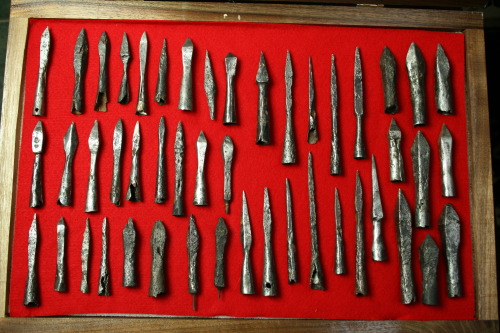Medieval Arrows FAQWhat it looked like: Long shaft with three fletchings at one end (curved halves o
Medieval Arrows FAQWhat it looked like: Long shaft with three fletchings at one end (curved halves of feathers most common). Different sizes and shapes of heads, including triangle-shaped and three-edged.Dimensions: Average length would be around 30 inches, diameter around one half inch to as small as three-eighths of an inch. Fletchings went from around six inches to two and a half inches in length and one half inch in height. Bodkin heads - a three or four sided square point, most commonly two inches with a weight of half an ounce, though sometimes went up to five inches and two ounces. Crossbow bolt was often nine to 15 inches long.How it worked: The feathers help keep the arrow flying along a path against air currents and its own spinning. Wanted to have small fletching so as not to give drag to the arrow, but the heavier the arrow, the larger the required fletchings.Materials: wood: brazil, hornbeam, birch, ash, oak, blackthorn, and beech. Claim that ash was the best. Iron or steel was used to make the head of the arrow, and feathers (often goose) for the fletching.Person who made it: Fletcher.Where to get materials: Most materials easy to attain in each home country like geese, but some of the fancier arrows may have had wood imported from India like brazilwood (the country was named after the wood instead of the other way around).Cost: Iron heads of crossbow bolts ranged from 26 shillings to 34 shillings for a thousand, longbow arrows cost around 100 shillings for a thousand.Other things needed for it: Bows (longbows or crossbows). Quivers, often a canvas bag that would be tied around the waist or back that would cover the entire arrow to keep them from falling out or from getting wet (unlike the leather ones that are modern in design).What changes occurred and when: Different types of arrows included barbed arrows (like the bodkin-head) with a square point. Broad arrows with a side-bladed head had a flat triangle shape. Livery arrows (also called sheafs) were used with old English longbows and had a few of these types of heads. Bolts (also called quarrels) were used for crossbows and often had a tip with four short spikes at each corner. These were very good at getting through plate armor.How common: Used in every battle as well as while hunting. Each archer got a few bags, or sheafs, of arrows. Later crossbow bolts for hunting were given dull points with drugs that would stun an animal instead of kill.image: Crossbow Bolt and Arrow Heads 14th-17th century (x) -- source link
#arrows#archery#master post#weaponry#faq

